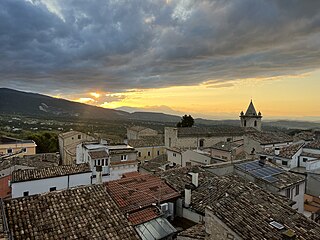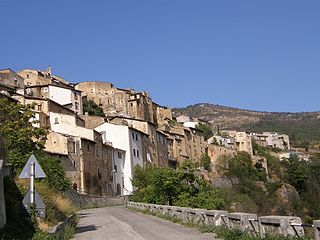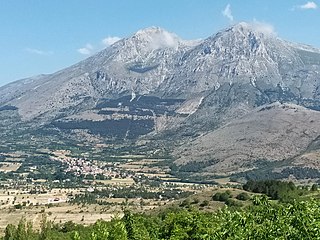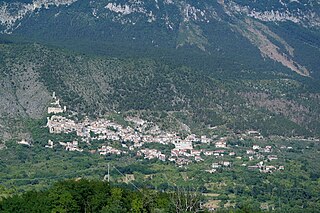
L'Aquila is a city and comune in central Italy. It is the capital city of both the Abruzzo region and of the Province of L'Aquila. As of 2024, it has a population of 69,902 inhabitants. Laid out within medieval walls on a hill in the wide valley of the Aterno river, it is surrounded by the Apennine Mountains, with the Gran Sasso d'Italia to the north-east.

Gissi is a town and comune located in the Province of Chieti, Abruzzo, Italy.

The province of L'Aquila is the largest, most mountainous and least densely populated province of the Abruzzo region of Italy. It comprises about half the landmass of Abruzzo and occupies the western part of the region. It has borders with the provinces of Teramo to the north, Pescara and Chieti to the east, Isernia to the south and Frosinone, Rome and Rieti to the west. Its capital is the city of L'Aquila.

The province of Chieti is a province in the Abruzzo region of Italy. Its provincial capital is the city Chieti, which has a population of 50,770 inhabitants. The province has a total population of 387,649 inhabitants as of 2017 and spans an area of 2,599.58 square kilometres (1,003.70 sq mi). The province contains 104 comuni. Its provincial president is Mario Pupillo.

Guardiagrele is a town and comune in the province of Chieti, part of the Abruzzo region of central Italy. It is in the foothills of the Maiella mountain at an elevation of around 576 metres (1,890 ft). Its population numbers about 10,000.

Penne is an Italian town in the province of Pescara, in the Abruzzo region, in mid-southern Italy. According to the last census in 2014 the population was 12,451. It is one of I Borghi più belli d'Italia.

Caporciano is a town and comune in the province of L'Aquila, in the region of Abruzzo, southern Italy.

Scanno is a town and district in the province of L'Aquila, in the Abruzzo region of central Italy. It is one of I Borghi più belli d'Italia.

Tagliacozzo is a town and comune in the province of L'Aquila, Abruzzo, central Italy. It is one of I Borghi più belli d'Italia.

Scerni is a town of 3,645 inhabitants of the province of Chieti is part of the Middle Vastese. Total area is 41 square kilometres (16 sq mi), and population density is 89 inhab/km2. The county has borders with Atessa, Gissi, Monteodorisio and Pollutri.

Acciano is a comune in the Province of L'Aquila in the Abruzzo region of Italy. The small, medieval village is in the Subequana valley and is a part of the Sirentina Mountain Community.
Barrea is a comune in the province of L'Aquila in the Abruzzo region of Italy.

Bugnara is a comune and village in the province of L'Aquila in the Abruzzo region of southern Italy. It is one of I Borghi più belli d'Italia.

Massa d'Albe is a comune and town in the province of L'Aquila in the Abruzzo region of central Italy. It is part of the Marsica.

Poggio Picenze is a comune and town in the province of L'Aquila in the Abruzzo region of Italy. Poggio Picenze is a small city with about 1,000 inhabitants. Located on Italy's Highway 17, it is 14 kilometres (9 mi) from the Abruzzese Apennines and about 12 kilometres (7 mi) from the city of L'Aquila. It sits 760 metres (2,490 ft) above sea level and overlooks the Aquila basin. It is also part of the mountain community of Campo Imperatore-Piana Navelli.

Roccacasale is a comune in the Province of L'Aquila in the Abruzzo region of Italy. Built on the slopes of the Monte della Rocca in the central Apennines, the village overlooks the Peligna Valley and the town of Sulmona.

Santo Stefano di Sessanio is a comune and hill town in the province of L'Aquila in the Abruzzo region of southern Italy. Located in the Gran Sasso e Monti della Laga National Park, in the highest region of the Apennines, this medieval hill town sits adjacent to the high plain of Campo Imperatore. It is one of I Borghi più belli d'Italia.

Scurcola Marsicana is a comune and town in the province of L'Aquila, in the Abruzzo region of central Italy.

A rocca is a type of Italian fortified stronghold or fortress, typically located on a hilltop, beneath or on which the inhabitants of a historically clustered village or town might take refuge at times of trouble. Generally under its owners' patronage, the settlement might hope to find prosperity in better times. A rocca might in reality be no grander than a fortified farmhouse. A more extensive rocca would be referred to as a castello.
The following is a timeline of the history of the city of L'Aquila in the Abruzzo, a region of Italy.





















